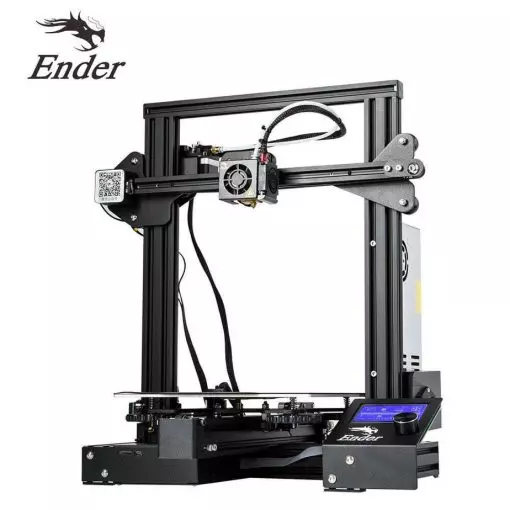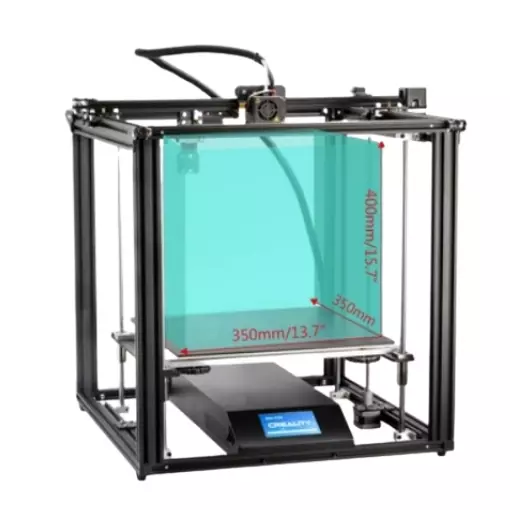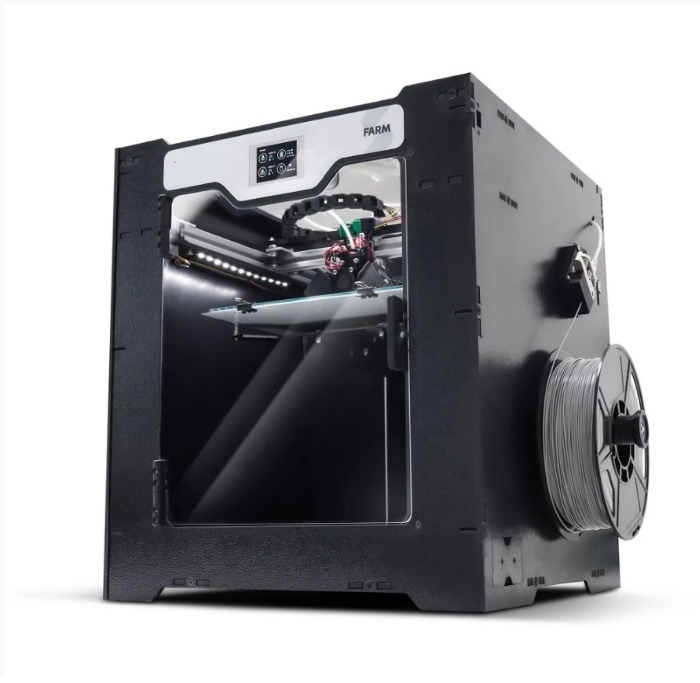Compare Ender 3 vs Ender 5 Plus vs FARM
Comparison between the best 3D printers
Choose the best 3D printer at the best price. The cheapest 3D printers are here.
Buy a 3D printer here with 3D Fila.
 |
 |
 |
|
| Model | Ender 3[BUY Ender 3] |
Ender 5 Plus[BUY Ender 5 Plus] |
FARM |
| Printing Material | Filament | Filament | Filament |
| Estimated price | $210,00 | $599,00 | $1127,00 |
| Fabricante | Creality 3D | Creality 3D | Sethi 3D |
| Release Year | 2018 | 2019 | 2021 |
| Print Volume [mm] | 220x220x250 | 350x350x400 | 240x240x240 |
| Printer Size [mm] | 440x440x465 | 632x619x666 | 550x42x500 |
| Weight [kg] | 6,62 | 18,2 | 15,7 |
| Power Loss Recovery | NO | YES | YES |
| Enclosed printer | NO | NO | NO |
| Bed Leveling | Manual | Automatic | Automatic |
| Filament End Sensor | NO | YES | YES |
| Bed type | Heated | Heated | Heated |
| Power supply system | Bowden | Bowden | Bowden |
| Standard nozzle | 0,4 | 0,4 | 0,4 |
| Maximum Nozzle Temperature [°C] | 255 | 260 | 270 |
| Maximum Bed Temperature [°C] | 110 | 100 | 120 |
| Maximum printing speed [mm/s] | 180 | 180 | 80 |
| Filament holder | YES | YES | YES |
| Camera for supervision | NO | NO | NO |
| Recommended filaments | PLA, TPU, ABS, PETG | PLA, TPU, ABS, PETG | PLA, PETG, Tritan, Flex, ABS |
| Recommended slicers | Cura, Simplify, Slic3r | Cura, Simplify, Slic3r | Cura, Simplify, Slic3r |
| Maximum Resolution [mm] | 0,1 | 0,1 | |
| Processor | 8 bits | 32 bits | |
| Display | Mono | Touchscreen TFT 4,3'' | Touchscreen TFT |
| Power Supply | 24V / 270W | 24V / 504W | 450 W |
| Connectivity | SD / USB | SD / USB | USB |
| Operating systems | Windows, Mac, Linux | Windows, Mac, Linux | Windows, Mac, Linux |
| Date of registration in the system | 2021-04-13 | 2021-04-14 | 2022-10-11 |
| Release date | 2018 | 2019 | 2021 |
| Extra features | The Ender 3 V1 is a DIY assembly 3D printer, a sales leader since 2017, standing out for its cost-benefit. With a wide printing capacity, it has a CNC machined structure for precision and stability. It offers high-precision prints with low noise, thanks to its innovative V-profile and pulleys. It has a self-adhesive magnetic platform for easy removal of models and excellent adhesion. The Ender 3 heats up quickly, reaching 100°C in 5 minutes, ideal for agile prints. It includes protection against power failures, allowing you to resume printing after interruptions, saving time and material. | The Ender 5 Plus offers a large print volume (350x350x400 mm) and fast assembly. It includes a BLTouch sensor, but with range limitations. It stands out for its dimensional accuracy, although it requires adjustments to the slicer settings. Despite the noise, its integrated design saves space, and includes features such as a filament sensor and power resumption. Ideal for large projects, it requires refinement in the settings for high-quality prints. | Sethis Farm printer offers a generous 240 x 240 x 240 mm print area, ideal for large projects. Its intuitive touchscreen display makes it easy to operate, while the intelligent sensor prevents problems by detecting filament shortages or jams. Its power recovery feature allows you to resume printing after interruptions. It stands out for its 9-point optical auto-leveling and high-performance heated bed, ensuring accuracy and versatility on different materials. Its 32-bit electronics and silent drivers promote a smooth and efficient experience. In addition, the Farm has a closed cabinet, expanding the range of usable polymers, and a turbo cooling system to speed up the process between prints. The machine also offers practicality with a storage drawer and simplified software updates. |
| Support for multiple colors and materials (AMS and CFS) | NO | NO | NO |
Notes * |
|||
| Cost-benefit | 6 / 10 | 6 / 10 | 6 / 10 |
| Hardware | 0.5 / 10 | 2 / 10 | 3 / 10 |
| Screen | . | . | . |
| Print volume | 3 / 10 | 4 / 10 | 3 / 10 |
| Performance | 1 / 10 | 1 / 10 | 0 / 10 |
| [BUY Ender 3] | [BUY Ender 5 Plus] |
Conclusion |
| In comparing the three 3D printers—the Ender 3, Ender 5 Plus, and the Sethi Farm—it's evident that each model caters to different user needs, budgets, and printing requirements. The **Ender 3** stands out as an exceptional entry-level option, offering impressive cost-efficiency alongside a respectable print volume. It provides the basic features necessary for enthusiasts and beginners, such as a heated bed and a decent maximum resolution. While it lacks advanced features like power loss recovery and an automatic bed leveling system, its affordability and solid performance make it a favorite among hobbyists looking for great value at a lower price point. On the other hand, the **Ender 5 Plus** elevates the printing experience with a larger print volume, automatic bed leveling, and a filament end sensor—features that enhance usability and convenience. However, it forgoes some of the cost-effectiveness of the Ender 3, making it a more considerable investment. Its good dimensional accuracy and build quality impress, but it lacks some of the advanced functionalities seen in more expensive models, which may deter users seeking higher performance for more demanding projects. The **Sethi Farm** is the most premium model, offering advanced features such as a 32-bit processor, auto-leveling capabilities, and enhanced material support. It is ideal for more serious users or commercial settings given its larger operational volume and superior construction. However, the higher price point may not appeal to casual users who perceive it as an excessively costly option without clear advantages for their intended use. In conclusion, if the priority is budget and basic functionality, the **Ender 3** is the most appealing choice. For those willing to spend more for better features but who still want a balance of cost and performance, the **Ender 5 Plus** presents a good middle ground. Conversely, the **Sethi Farm** is best suited for professionals or serious hobbyists who require the highest levels of performance and versatility, albeit at a premium. Ultimately, the choice depends on the specific needs, budget, and goals of the user. |

